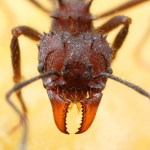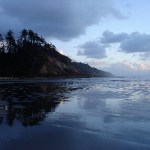genomics
I've been fine tuning Ubuntu all day with goodies and getting drivers to work right, so I missed this paper on African genetics:
Africa is the source of all modern humans, but characterization of genetic variation and of relationships among populations across the continent has been enigmatic. We studied 121 African populations, 4 African American populations, and 60 non-African populations for patterns of variation at 1327 nuclear microsatellite and insertion/deletion markers. We identified 14 ancestral population clusters in Africa that correlate with self-described ethnicity and shared…
Today, Roche announced funding for over a dozen genomes of organisms associated with the agricultural attine ants and the fungus they cultivate. In honor of the occasion, here's a sampling of a few of the attine species and their gardens.
Acromyrmex sp. nr. crassispinus, Argentina.
The fungus of the texan species Mycetosoritis hartmanni is grown on a substrate of caterpillar frass. Not all the attines are leaf-cutters!
Acromyrmex lundii, Argentina.
Apterostigma auriculatum, Panama.
Atta texana, Texas.
Cyphomyrmex wheeleri, Arizona.
Trachymyrmex pomonae, Arizona.
The…
Atta cephalotes, in the fungus garden
Big ant news today! Roche Applied Sciences is apparently funding the sequencing of a series of genomes- three ant and an array of fungal and microbial genomes- in an ambitious project to better understand the relationships among the players in the celebrated ant-fungus relationship. The sequencing project is headed by Nicole Gerardo of Emory University and Cameron Currie of the University of Wisconsin.
This trend in genomics away from sequencing isolated organisms in favor of comparative projects is a welcome one. With multiple…
...asked Joe. Answer: only a few days to sequence, clean up the data, and submit to NCBI. Seven H1N1 swine flu sequences are up (H/T Jonathan Eisen). I've not had a chance to crack anything open yet, but I hope to see some analysis from more of the genomics geeks soon...However, one bummer is that they don't have any from the Mexico cases available--and particularly, any sequence data from any of the fatal cases. These will be helpful to see if there are any point mutations that could possibly account for a virulence difference between the Mexican and US cases. (Unlikely, I'd guess,…
There are some papers out on the genome of the domestic cow out right now. ScienceNews has an overview:
Two competing research teams have cataloged the "essence of bovinity" found in the DNA of cattle, but not without disagreement on some essential points.
Reporting online April 23 in Science and April 24 in Genome Biology, the two groups compiled drafts of the bovine genome, identifying genes important for fighting disease, digesting food and producing milk.
I don't see the Genome Biology paper on the site yet, but there are two in Science. First, The Genome Sequence of Taurine Cattle: A…
A much more thorough post by Dan MacArthur on the recent issue of the New England Journal of Medicine & genomics.
The New England Journal of Medicine has a series of articles up on the impact of new genomic techniques on medicine, specifically in the domain of pinpointing genetic markers which are correlated with increased risk of a particular disease. David Goldstein has a skeptical take up on the future returns of genomewide association studies, while Joel Hirschhorn is more hopeful. There is another review which takes a middle path, emphasizing the relatively marginal predictive power of many of the risk alleles, but suggesting that techniques and results are bound to improve.
Probably the most…
Science News has an interesting piece up, Shared Differences: The architecture of our genomes is anything but basic. The main focus is on genetic variation, the possibility that there might be important information in copy number variance, and that the common disease-common variant hypothesis is dead. At least for complex traits that we're interested in like schizophrenia. If any of this is unfamiliar or confusing, I recommend the article, it even has references to the primary literature that you can follow up on.
Watching the chIPs roll in,
then I watch them roll away again,
I'm just sitting on the DNA,
wasting time
(sung to the tune of "Sitting on the dock of the bay" by Otis Redding)
Hesselberth et.al. recently published a paper about digital genomic
footprinting that blew me away because it has so much potential. The authors used DNAse I and Next Generation DNA Sequencing to map every site in the yeast genome where a protein might be sitting.
Since I used to do similar kinds of experiments, albeit on a much, much smaller scale, this sort of publication boggles my mind. It's only recently that I've…
For the past few months, the shake-up that began with Next Generation DNA Sequencing has been forcing me to adjust to a whole new view of things going on inside of a cell. We've been learning things these past two years that are completely changing our understanding of the genome and how it works and it's clear we're never going back to the simple view we had before.
What's changed? The two most striking changes, to me at least, are the new views of the way the genome is put together and what the cell does with the information.
They just don't assemble chromosomes like they used to.
I used to…
John Hawks & Daniel MacArthur have already pointed to a new paper in Genome Research, Signals of recent positive selection in a worldwide sample of human populations. As Dan notes, it's Open Access, so you can read the PDF yourself. That being said, "Just read it!" might be somewhat a tall order if you don't have some background, so make sure to read the papers at this link. In particular the paper refers to two tests for detecting natural selection which utilize haplotype structure, integrated haplotype score (iHS) and cross population extended haplotype homozygosity (XP-EHH).
One of…
By way of ScienceBlogling Sandra Porter, we discover that Cofactor Genomics has announced that they will sequence some genomes for free to enable students to learn about genomics:
In response to a great post on Keith Robison's "Omics Omics" blog which highlighted how Next-Gen DNA sequencing platforms could change the science classroom as we know it:
http://omicsomics.blogspot.com/2009/03/next-level-in-genomics-term-papers.html
Cofactor will ask course organizers for a 1 page description of how their ~700Mb sequencing project could be used as an effective teaching aid in their class. We will…
Sixty-five million years ago, life on Earth was sorely tested. One or more catastrophic events including a massive asteroid strike and increased volcanic activity, created wildfires on a global scale and dust clouds that cut the planet's surface off from the sun's vital light. The majority of animal species went extinct including, most famously, the dinosaurs. The fate of the planet's plants is less familiar, but 60% of those also perished. What separated the survivors from the deceased? How did some species cross this so-called "K/T boundary"?
Jeffrey Fawcett form the Flanders Institute for…
What do the missing Romanov children, genetically engineered humans, financial risk taking, and poop have in common?
You can read about all these topics from this month's Gene Genie carnival at Mary Meets Dolly.
Who would have thought that mutations could be so much fun?
Cofactor Genomics is offering to sequence a genome for a few classes for free using Next Generation DNA Sequencing technology (either Illumina GA or via AB SOLiD).
Quoting from their site:
Cofactor will ask course organizers for a 1 page description of how their ~700Mb sequencing project could be used as an effective teaching aid in their class. We will review and choose the best entries during the month of May. Those entries will be awarded a free sequencing project including project experimental design, sample QC, library construction, sequencing, and computational analysis. Those projects…
"Digital biology," as I use the phrase, refers to the idea of using digital information for doing biology. This digital information comes from multiple sources such as DNA sequences, protein sequences, DNA hybridization, molecular structures, analytical chemistry, biomarkers, images, GIS, and more. We obtain this information either from experiments or from a wide variety of databases and we work with this information using several kinds of bioinformatics tools.
The reason I'm calling this field "digital biology" and not "bioinformatics" (even though I typically use the terms as…
A while ago, economist Paul Krugman described the institutional loss of knowledge in the discipline of economics:
And the latter group, the equilibrium macro side, was so convinced of the logical correctness of its position that schools dominated by that view stopped teaching demand-side economics. (Schools dominated by new Keynesians, on the other hand, did teach real business cycle theory.) I haven't been able to dig up the quote, but somewhere along the line Ed Prescott declared that his students wondered who Keynes was, because he was never mentioned in their courses.
And those trained…
If you read an older work like The History and Geography of Human Genes based on classical genetic markers Sardinia stands out on charts of genetic distance. This is probably due to the fact that Sardinia is an island and gene flow from surrounding regions is relatively limited due to the physical barriers. So the first settlers have an outsized genetic impact which is not diluted over time by intermarriage with surrounding populations. Additionally, because an island can be treated as an isolate, that reduces effective population and increases the power of random genetic drift, which will…
This is the eighth of eight posts on evolutionary research to celebrate Darwin's bicentennial.
In Virginia, USA, sits a facility called the American Type Culture Collection. Within its four walls lie hundreds of freezers containing a variety of frozen biological samples and among these, are 99 strains of the common cold. These 99 samples represent all the known strains of the human rhinoviruses that cause colds. And all of their genomes have just been laid bare.
Ann Palmenberg from the University of Wisconsin and David Spiro from the J. Craig Venter Institute have cracked the genomes of all…
This is the sixth of eight posts on evolutionary research to celebrate Darwin's bicentennial.
Physically, we are incredibly different from our ape cousins but genetically, it's a different story. We famously share more than 98% of our DNA with chimpanzees, our closest living relatives. Our proteins are virtually identical and our chromosomes have more or less the same structure. At the level of the nucleotide (the "letters" that build strands of DNA), little has happened during ape evolution. These letters have been changing at a considerably slower rate than in our relatives than in other…

